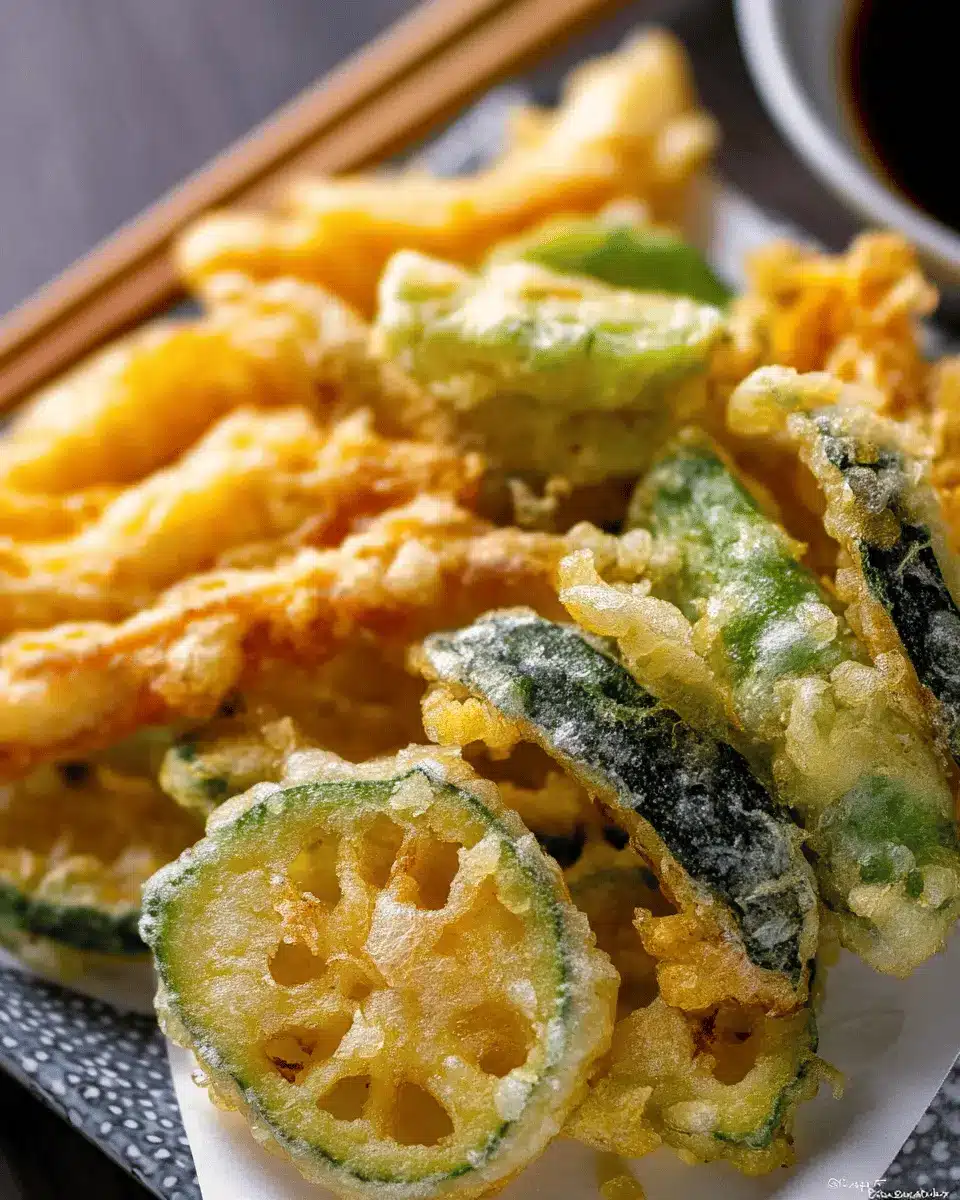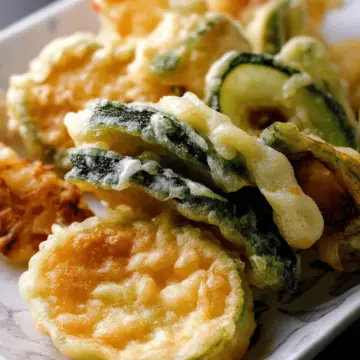Introduction to Vegetable Tempura
When you're craving something crispy and delightful, vegetable tempura might just be the perfect dish to prepare at home. This Japanese favorite not only offers an amazing crunch but also a lightness that makes it feel less heavy than other fried foods. With the right technique, it’s surprisingly easy to recreate that perfectly airy coating from your favorite restaurant.
Why Vegetable Tempura is the Perfect Homemade Dish
One of the best aspects of vegetable tempura is its versatility. You can use an array of seasonal vegetables like sweet potatoes, kabocha squash, and eggplant, making it ideal for any time of year. Plus, you get to control every element of the dish, from the freshness of your ingredients to the warm, savory dipping sauce known as Tentsuyu.
Making tempura at home can be a delightful ritual. You can invite friends over, share the cooking process, and transform it into a fun, interactive dining experience. Did you know that the secret to achieving that coveted crispiness lies in using icy cold water and keeping the batter minimally mixed? This not only enhances the texture but also ensures that it doesn’t absorb too much oil during frying, leading to a guilt-free indulgence.
For more insights into mastering tempura, check out this article on cooking techniques from Japanese Cooking 101, which dives deeper into the art of making this dish. It’s a culinary adventure you won't want to miss!

Ingredients for Vegetable Tempura
Creating the perfect Vegetable Tempura starts with selecting the right fresh vegetables and ingredients. Here's a breakdown to help you get started!
Fresh Vegetables for the Tempura
For a delightful veggie medley, choose a variety of fresh, seasonal vegetables. Recommended options include:
- Japanese sweet potato (Satsumaimo) – sweet and beautifully textured
- Kabocha squash – adds a creamy consistency
- Lotus root (renkon) – provides unique crunchiness
- King oyster mushrooms (eringi) – flavorful and tender
- Japanese or Chinese eggplant – lends subtle taste and soft texture
- Shiso leaves (perilla/ooba) – fragrant touch that enhances the overall flavor
Essential Ingredients for the Batter
Achieving a light and crispy batter is key for the perfect Vegetable Tempura. You’ll need:
- All-purpose flour (plain flour) – chilled to ensure crispiness
- Iced water – keeps the batter cold, preventing it from absorbing too much oil
- Large egg – adds richness and binds the ingredients together
Dipping Sauce Components
No tempura is complete without a delicious dipping sauce, or tentsuyu. Gather these components:
- Dashi (Japanese soup stock) – forms the base for that umami flavor
- Soy sauce – adds depth and seasoning
- Mirin – brings sweetness
- Sugar – balances the flavor
Now that you've got your ingredients ready, you're all set to make some crispy, mouthwatering Vegetable Tempura! If you want to dive deep into the preparation steps, check out the full recipe in this article. Happy cooking!
Step-by-step Preparation of Vegetable Tempura
Vegetable Tempura is a delightful dish that combines a variety of vegetables, a light and crispy batter, and a flavorful dipping sauce, making it not just a culinary pleasure but also a visual treat. Follow along to master the art of making this beloved Japanese dish.
Prepare the Dipping Sauce (Tentsuyu)
Start your tempura journey by preparing the dipping sauce, or tentsuyu, that elevates the entire dish. In a small saucepan, combine:
- ¾ cup dashi (Japanese soup stock)
- 3 tablespoon soy sauce
- 2 tablespoon mirin
- 2 teaspoon sugar
Bring this mixture to a boil, then reduce the heat and let it simmer until the sugar has dissolved. This sauce not only adds a depth of flavor but also enhances the crispy goodness of your Vegetable Tempura. For more on crafting homemade dashi, check out this detailed guide on Making Dashi.
Prepare the Vegetables for Tempura
While the sauce cools, focus on prepping your veggies. Choose seasonal favorites like:
- Japanese sweet potato (Satsumaimo)
- Kabocha squash
- Lotus root
- King oyster mushrooms
- Japanese or Chinese eggplant
- Shiso leaves
Slice the sweet potato into ¼-inch rounds and soak them in water for 15–30 minutes to draw out excess starch. Next, cut the kabocha and lotus root into similar-sized pieces. For the mushrooms, slice lengthwise, and don’t forget to cut your eggplant last to maintain its freshness. Leave those vibrant shiso leaves whole for a touch of herbal delight.
Heat the Oil to the Right Temperature
Getting the temperature right is crucial for tempura. Pour about 4 cups of neutral oil into a deep fryer or pot, heating it to 320°F (160°C). Use an instant-read thermometer for precision. If you don’t have one, you can check if the oil is ready by dipping wooden chopsticks—small bubbles forming around them is your cue. Pro tip: For an extra fragrant touch, you can mix in a bit of sesame oil.
Make the Light and Crispy Batter
While the oil warms, it’s batter time! For a classic tempura batter, you want a 1-to-1 ratio of flour to egg and iced water.
- Sift 1 cup of all-purpose flour into a large bowl.
- In a separate bowl, mix 200 ml iced water with 1 large egg until frothy.
- Slowly combine the two while mixing with chopsticks in a gentle figure eight. Remember, lumps are okay; over-mixing can make it dense!
Keeping the batter chilled is key—consider placing the batter bowl in ice water or adding a couple of ice cubes.
Deep-Fry the Vegetables
With everything prepped, it’s time to fry! Start with the root vegetables like sweet potatoes and lotus root, frying them for 3-4 minutes per batch at 320°F (160°C) until golden. Clean out crumbs between batches to keep your oil clear.
Next, turn up the heat to 338–356°F (170–180°C) for the kabocha, eggplant, and mushrooms, frying them for 1–2 minutes. Finish off with the shiso leaves for just 15–20 seconds. Look for a beautiful golden hue to ensure they’re perfectly crispy.
Serve with Grated Daikon
To complete your Vegetable Tempura experience, grate some daikon radish and serve it alongside your tentsuyu dipping sauce. Mixing in some daikon will provide a refreshing bite that complements the tempura beautifully.
Now, gather your friends or family, serve your stunning Vegetable Tempura hot, and enjoy how the crisp, airy batter contrasts with the fresh vegetables. It's not just a meal; it's a celebration of flavors and textures. Happy cooking!

Variations of Vegetable Tempura
Seasonal Vegetable Tempura
One of the best parts of making vegetable tempura is the opportunity to use seasonal veggies! In spring, consider asparagus and young greens, while summer calls for zucchini and bell peppers. Autumn can showcase root vegetables like carrots and butternut squash, and winter's choice might include hearty vegetables like Brussels sprouts and cauliflower. Each season brings a unique flavor profile to your tempura, allowing for creativity in the kitchen. Don't be afraid to experiment; you might discover a new favorite combination!
Unique Dipping Sauce Variations
While the classic dipping sauce for vegetable tempura is delicious, why not switch things up? You can create a spicy dipping sauce by adding a touch of sriracha or sesame oil for a flavorful kick. Another option is a citrus ponzu, combining soy sauce with citrus juice for a bright, zesty twist. If you're feeling adventurous, try a miso-based sauce for depth—simply mix miso paste with vinegar and a bit of sugar! These variations keep things interesting and elevate your dining experience.
For further reading on tempura techniques and other dipping sauce ideas, Cooking Light offers great insights.
Cooking Tips and Notes for Vegetable Tempura
Achieving the Perfect Crisp
To create that iconic crispy texture in your vegetable tempura, keep your batter cold and lumpy! Mixing vigorously introduces too much gluten, which leads to a chewy coating. Instead, aim for a light and airy batter by incorporating ice water and just a bit of egg.
Also, maintaining the oil temperature is crucial; too low, and your tempura ends up greasy. Aim for around 320°F (160°C) for root vegetables, then increase to 338-356°F (170-180°C) for quicker-cooking options.
Avoiding Common Mistakes
One common pitfall is not drying vegetables thoroughly after washing, which can lead to sogginess. Always pat your veggies dry before dipping them in batter. Additionally, frying in batches ensures a better temperature control—crowding the pot can drop temperatures significantly, resulting in a lackluster crunch.
If you're looking for more tips, check out resources like Serious Eats on tempura techniques to elevate your culinary game!

Serving Suggestions for Vegetable Tempura
Pairing Tempura with Rice
To enhance the flavors of your Vegetable Tempura, serve it alongside a steaming bowl of white rice or even sushi rice. The rice acts as a perfect canvas to balance the crispy texture and rich flavors of the tempura. Consider drizzling soy sauce over the rice for an extra savory touch. If you're feeling adventurous, you could also pair it with a refreshing light salad, perhaps with a citrus vinaigrette, to create a delightful contrast to the tempura's crispiness.
Creative Serving Styles
Get creative with your presentation! Arrange the Vegetable Tempura artfully on a platter, garnished with shiso leaves and served with small bowls of warm tentsuyu dipping sauce. This not only looks visually appealing but also invites your guests to serve themselves. Alternatively, consider creating tempura sushi rolls by wrapping the tempura in sushi rice and nori, adding a unique twist to traditional sushi. This way, you can experience two delicious Japanese cuisines in one meal!
For more serving ideas, check out serious eats or japan center.
Time Breakdown for Vegetable Tempura
Preparation Time
Get your kitchen ready in just 25 minutes, allowing ample time to slice those beautiful vegetables and whip up your batter. Just imagine the aroma filling your kitchen!
Cooking Time
The frying process will take about 45 minutes, but it’s worth every second! You’ll be mesmerized by how quickly the tempura transforms into crispy, golden perfection.
Total Time
In total, you’ll spend around 1 hour and 10 minutes to create this delightful Vegetable Tempura. It's a fantastic way to share a delicious meal with friends or family, so grab your ingredients and let’s get started!
Nutritional Facts for Vegetable Tempura
Calories and Nutritional Content
Homemade Vegetable Tempura packs a satisfying 652 calories per serving, making it a delicious but indulgent treat. Here’s a quick breakdown of its nutritional content:
- Carbohydrates: 82g
- Protein: 16g
- Fat: 30g (including 23g of saturated fat)
- Fiber: 12g
- Vitamins: High in Vitamin A and moderate in Vitamin C
Health Benefits of Vegetable Tempura
Though it's a fried dish, Vegetable Tempura can be part of a balanced diet. The tempura method enhances the natural flavors and nutritional profiles of the vegetables used. For example, the sweet potato and kabocha squash provide antioxidants, while the fiber content aids digestion. Enjoying tempura alongside a healthful dipping sauce like Tentsuyu can further elevate the nutritional value! Check out this study on the benefits of eating more vegetables.
Including the right ingredients in your Vegetable Tempura means you can savor both taste and health in every crispy bite!
FAQs about Vegetable Tempura
What vegetables are best for tempura?
When it comes to Vegetable Tempura, the choice of vegetables is key. Some favorites include:
- Japanese sweet potatoes (Satsumaimo) for sweetness.
- Kabocha squash for a creamy texture.
- Lotus root (renkon) to add a nice crunch.
- King oyster mushrooms for their meaty bite.
- Eggplant, which becomes tender and succulent when fried.
Feel free to experiment with seasonal veggies; just ensure they’re cut into similar sizes for even cooking.
Can I make the batter ahead of time?
It’s best to whip up the tempura batter right before frying. While you can prep all your ingredients in advance, the batter should be kept cold and made just before cooking to maintain its airy texture.
How do I store leftover tempura?
Leftover tempura can be stored easily! Place it in a single layer between paper towels inside an airtight container. This helps absorb excess moisture. For longer storage, freeze it for up to two weeks. Reheat in a 400ºF oven to restore that delightful crispiness.
Enjoying Homemade Vegetable Tempura
In conclusion, making Vegetable Tempura at home is not just about enjoying a delicious treat; it’s an experience. With your family or friends gathered around, dipping crispy tempura in a savory tentsuyu sauce, you create lasting memories. So, grab your ingredients and enjoy this delightful journey of flavors!
For those who want to explore more about tempura techniques, check out Fine Cooking's guide on deep-frying for tips on achieving the perfect crunch!

Vegetable Tempura 野菜の天ぷら
Equipment
- deep fryer or pot
Ingredients
Vegetables
- 1 whole Japanese sweet potato (Satsumaimo) unpeeled
- ⅛ whole kabocha squash unpeeled and seeded
- 2 inches lotus root (renkon) peeled and precooked
- 2 whole king oyster mushrooms (eringi)
- 1 whole Japanese or Chinese eggplant
- 4 leaves shiso leaves (perilla/ooba)
Batter
- 1 cup all-purpose flour (plain flour) chilled
- 200 ml iced water
- 1 large egg chilled
Dipping Sauce (Tentsuyu)
- ¾ cup dashi (Japanese soup stock)
- 3 tablespoon soy sauce
- 2 tablespoon mirin
- 2 teaspoon sugar
For Deep-Frying
- 4 cups neutral oil or enough for 1½ inches of oil
- all-purpose flour (plain flour) for dusting
For Serving
- 2 inches daikon radish grated
Instructions
Preparation
- Weigh your ingredients using a kitchen scale.
- Slice Japanese sweet potato into rounds and soak in water for 15–30 minutes.
- Cut kabocha squash and lotus root into slices and soak lotus root in vinegared water for 5 minutes.
- Prepare the king oyster mushrooms by slicing them lengthwise.
- Keep shiso leaves whole.
- Cut eggplant immediately before frying.
Dipping Sauce
- Combine dashi, soy sauce, mirin, and sugar in a saucepan and simmer until sugar dissolves.
Making the Batter
- Sift flour into a bowl, add iced water and beaten egg. Mix gently.
Deep-Frying
- Heat oil and fry root vegetables until lightly golden.
- Fry kabocha, eggplant, and mushrooms at a higher temperature.
- Fry shiso leaves until lightly golden.
Serving
- Grate daikon radish and serve with tentsuyu dipping sauce.
Storing Leftovers
- Store leftover tempura in a single layer between paper towels in an airtight container.





Leave a Reply